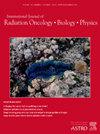Androgen Deprivation Therapy (ADT) and High Dose Definitive Radiotherapy (RT) ± Whole Pelvic RT in Patients with Unfavorable Intermediate or Favorable High-Risk Prostate Cancer: Early Results of a Phase III Randomized Controlled Trial
IF 6.5
1区 医学
Q1 ONCOLOGY
International Journal of Radiation Oncology Biology Physics
Pub Date : 2025-10-14
DOI:10.1016/j.ijrobp.2025.08.029
引用次数: 0
Abstract
Purpose/Objective(s)
Assess whether prophylactic whole pelvic radiotherapy (WPRT) improves overall survival (OS) compared to prostate only dose escalated radiotherapy (PORT) in patients with protocol defined unfavorable intermediate risk (UIR) or favorable high risk (FHR) prostate cancer (PC).
Materials/Methods
Eligible patients had localized prostate cancer with an estimated risk of lymph node involvement of ≥ 15% (Roach equation), and UIR or FHR (PSA <50 ng/ml clinical T1-2b, i.e., no T3’s) PC and a Zubrod of 0 or 1. Patients were stratified by the risk group, RT boost: brachytherapy (BT) vs intensity modulated RT (IMRT) to 79.2 Gy, and duration of ADT (4 to 6 vs 32 months) and randomized to PORT or WPRT (superior border at the L4-5 interspace), arms 1, and 2 respectively, with the primary endpoint OS. Staging and treatment were based on conventional imaging.
Results
From July 2011, thru June 24, 2019, 2473 (UIR=1130; FHR=1343) eligible and evaluable patients were accrued (median age 69 years). Approximately 30% of patients received long term ADT, 21% received a BT boost, 16% had a PSA > 20ng/mL, while 98% had a Gleason score of 7-10. At the planned interim analysis, WPRT did not improve OS, therefore the Data Safety Monitoring Committee released the data, with a median follow-up was 7.3 years (IQR 6.1-9.2), and 64 patients followed beyond 12 years. The 10-year OS was 68% (hazard ratio [HR]=1.01, 95% CI: 0.85-1.20, one-sided p=0.54), and PC specific survival (PCS) 98%, on both arms. The cumulative incidence of biochemical failure (BF) by the Phoenix definition at 10 years was 17% and 13% for arms 1 and 2, respectively (cause-specific HR=0.82, 95% CI: 0.65-1.03, one-sided p=0.045), but there was no difference in the risk of distant metastases (cause-specific HR=1.05, 95% CI: 0.73-1.50, one-sided p=0.60). The maximum gastrointestinal (GI) grade 2 (CTCAE version 4) adverse event rate was 14.7% on the PORT arm vs 18.7% on the WPRT arm (p=0.0035, one-sided). However, there was no difference in grade ≥3 GI adverse events being 3.4% on the PORT vs 3.3% on the WPRT arm. The reported rate of grade 2 and ≥ 3 urinary frequency was 24.8 and 0.5% on the PORT arm respectively, vs 26.5 and 0.7% on the WPRT arm.
Conclusion
At 10 years, WPRT did not improve OS in men with UIR or FHR PC. However, the follow-up is relatively short, with most cancer related deaths expected beyond 10 years. Additional follow-up is warranted to determine whether the early trends in BF ultimately translate into differences in OS or metastases. The high PCS rate and relatively low morbidity (by physician report) confirms that ADT + PORT appears to represent an excellent treatment option for men with UIR or FHR PC. Future studies incorporating biomarkers may help us determine whether there are subsets of patients who would benefit from WPRT.
一项III期随机对照试验的早期结果:雄激素剥夺治疗(ADT)和高剂量确定放疗(RT)±全盆腔放疗治疗中高危或高危前列腺癌患者
目的/目的:评估对于方案定义为不良中危(UIR)或高危(FHR)前列腺癌(PC)的患者,与仅前列腺剂量递增放疗(PORT)相比,预防性全盆腔放疗(WPRT)是否能提高总生存率(OS)。材料/方法入选的患者为局限性前列腺癌,估计淋巴结受累性风险≥15% (Roach方程),UIR或FHR (PSA <;50 ng/ml临床T1-2b,即无T3) PC和Zubrod为0或1。患者按风险组分层,放疗增强:近距离放疗(BT) vs强度调节放疗(IMRT)至79.2 Gy, ADT持续时间(4至6个月vs 32个月),随机分为PORT或WPRT (L4-5间隙上边界),1组和2组,主要终点OS。分期和治疗以常规影像学为基础。从2011年7月到2019年6月24日,共纳入2473例(UIR=1130; FHR=1343)符合条件且可评估的患者(中位年龄69岁)。大约30%的患者接受了长期ADT治疗,21%的患者接受了BT增强治疗,16%的患者PSA为20ng/mL, 98%的患者Gleason评分为7-10。在计划的中期分析中,WPRT没有改善OS,因此数据安全监测委员会发布了数据,中位随访时间为7.3年(IQR为6.1-9.2),64例患者随访时间超过12年。两组10年OS为68%(风险比[HR]=1.01, 95% CI: 0.85-1.20,单侧p=0.54), PC特异性生存率(PCS)为98%。根据Phoenix定义,第1组和第2组10年生化失败(BF)的累积发生率分别为17%和13%(病因特异性HR=0.82, 95% CI: 0.65-1.03,单侧p=0.045),但远处转移的风险无差异(病因特异性HR=1.05, 95% CI: 0.73-1.50,单侧p=0.60)。PORT组最大胃肠道(GI) 2级(CTCAE版本4)不良事件发生率为14.7%,WPRT组为18.7% (p=0.0035,单侧)。然而,≥3级胃肠道不良事件在PORT组为3.4%,而WPRT组为3.3%,没有差异。PORT组2级和≥3级尿频发生率分别为24.8%和0.5%,而WPRT组为26.5和0.7%。结论10年时,WPRT并没有改善UIR或FHR PC患者的OS。然而,随访时间相对较短,大多数与癌症相关的死亡预计超过10年。进一步的随访是必要的,以确定BF的早期趋势是否最终转化为OS或转移的差异。高PCS率和相对较低的发病率(医生报告)证实,ADT + PORT似乎是UIR或FHR PC患者的一种极好的治疗选择。纳入生物标志物的未来研究可能会帮助我们确定是否存在从WPRT中获益的患者亚群。
本文章由计算机程序翻译,如有差异,请以英文原文为准。
求助全文
约1分钟内获得全文
求助全文
来源期刊
CiteScore
11.00
自引率
7.10%
发文量
2538
审稿时长
6.6 weeks
期刊介绍:
International Journal of Radiation Oncology • Biology • Physics (IJROBP), known in the field as the Red Journal, publishes original laboratory and clinical investigations related to radiation oncology, radiation biology, medical physics, and both education and health policy as it relates to the field.
This journal has a particular interest in original contributions of the following types: prospective clinical trials, outcomes research, and large database interrogation. In addition, it seeks reports of high-impact innovations in single or combined modality treatment, tumor sensitization, normal tissue protection (including both precision avoidance and pharmacologic means), brachytherapy, particle irradiation, and cancer imaging. Technical advances related to dosimetry and conformal radiation treatment planning are of interest, as are basic science studies investigating tumor physiology and the molecular biology underlying cancer and normal tissue radiation response.

 求助内容:
求助内容: 应助结果提醒方式:
应助结果提醒方式:


